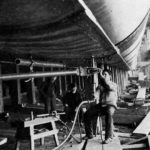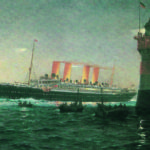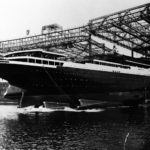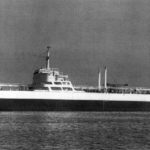
Founded in 1884 as German Shipyards Association the VSM (Verband für Schiffbau und Meerestechnik e.V.) today represents the political and commercial interests of the German maritime industry, comprising shipyards building ocean going and inland waterway vessels as well as marine equipment supplie[ds_preview]rs, classification societies, ship model basins and engineering consultants.
The responsibilities of the association include providing members with specialist advisory and support services and representing their interests in public and vis-à-vis political institutions. The VSM also promotes technical and commercial development in the shipbuilding and ocean industry in Germany and abroad. The Association represents its members nationally and internationally. VSM is a member of BDI (Bundesverband der Deutschen Industrie e. V.), the European shipbuilding organization CESA (Community of European Shipyards’ Associations) as well as the association of equipment manufacturers EMEC (European Marine Equipment Council).
1884: Founding of the German Shipbuilding Association
At a time when the international shipbuilding scene was significantly dominated by Great Britain as shipbuilding nation with a total share of 70-80 %, the German shipbuilding industry with only 5 % still mainly constructed wooden sailing vessels. German owners received their steamships from shipyards in the UK. Even after they had adopted the new designs German shipbuilder imported the material required for the construction from the British Island. In order to establish a solid shipbuilding industry in Germany, leading managers of shipyards and steel producers held a meeting in the Hamburg Streit’s Hotel in 1884 and soon thereafter the Shipbuilders Association was founded comprising ten of the most reputable shipyards in Northern Germany.
• Actien-Gesellschaft Vulcan, Stettin
• Actien-Gesellschaft Germania, Kiel
• Georg Howaldt, Kiel
• Bremer Schiffsbaugesellschaft, Bremen
• Blohm & Voss, Hamburg
• Flensburger Schiffsbaugesellschaft, Flensburg
• Actien-Gesellschaft Reiherstieg, Hamburg
• Henry Koch, Lübeck
• F. Schichau, Elbing
• Jos. L. Meyer, Papenburg
• Joh. Lange, Vegesack
• Tecklenborg-Werft, Geestemünde
(The last four shipyards joined the association immediately after its foundation).
Shipping lines in the UK already very early had received subsidies from their government for the Royal Mail service. They inter-connected the British Empire whose ports were spread all over around the globe. This comfortable system then had also been adopted by the German shipping community. The members of the newly established German shipbuilding association demanded from their government that any subsidies like the mail contracts for domestic shipping lines should only be granted to owners whose trading vessels were built at German yards.
Germany joins the club of shipbuilding nations
In the end of the 19th and during the beginning of the 20th century Germany emerged to become one of the leading shipbuilding nations, due to the considerable growth of the merchant fleet owing to the colonisation efforts of the German Emperor and the subsequent expansion of the German Navy. In 1904 the Shipbuilding Association counted 42 member yards and was responsible for the increasing reputation of the German shipbuilders and the skills of their engineers. A buoyant signal for the catching up of the industry was the first gaining of the »Blue Ribbon« for the fastest transatlantic passage by the German Steamer »Kaiser Wilhelm der Große« in 1897. Built at the yard Stettiner Vulkan for the Norddeutscher Lloyd the ship claimed its merits in both directions within a four months period. In 1900 the HAPAG-vessel »Deutschland« took over this honour (1903 in westerly direction) and forced the British shipping Industry to react. Cunard Line subsequently decided to order the fast steamers »Mauretania« and »Lusitania«. Contrary to owners in Germany Cunard Line was able to receive considerable subsidies from the UK-Government, as these ships were also used as test beds for the newly designed turbine propulsion for the British Navy.
World War One and the time between the wars
War activities during 1914–1918 seriously affected the merchant marine, however the year 1919 by many German owners was considered to have been the hardest. Tonnage that had so far survived the war was then confiscated by the Allies and the pride of the German shipbuilding industry changed its national flag involuntarily: the over 50.000 GRT passenger vessels »Imperator« and »Vaterland« – at the time the biggest of their kind – became the British »Berengaria« and the American »Leviathan«.
Upon having fairly recovered from the »bleeding« during and after the war the industry was again heavily affected by the economic turbulences in the »roaring twenties«. Figures for employed labour in shipbuilding deteriorated from previously 90.000 to around 10.000 in 1932. During the »Third Reich« the building of merchant ships was more and more repelled in favour of Navy vessels. The Association also became a victim of the general restructuring scheme of the Nazis and was dominated by the Berlin-controlled »Fachgruppe Schiffbau« (section shipbuilding) during this time.
New start from the scratch
Damages to shipping and the shipbuilding industry during WW II could by no means be compared with those of the previous war. Apart from the victims at sea many wracks had been sunk in the German port areas and installations ashore had seen fatal destructions of up to 80 %. The balance of any undestroyed parts was dismantled and demounted as far as the shipyards were concerned – especially those that had been building the huge battleships and the German submarines, which had formed a lethal threat to the UK during the war. Building of new vessels first was completely prohibited however the Allies gradually allowed to build bigger and stronger vessels within the first aftermath decade. In 1946 the association was newly established with 142 shipyards joining it in order to swiftly accelerate the revival of the industry.
To some extend the Korean War beginning the 1950s may have contributed to a more relaxed policy of the Western Allies that helped the German shipyards soon to become renowned participants of the international shipbuilding industry again. In 1953 the launching of the 45,000 tdw »Tina Onassis« testified the high performance skills of the German shipyards and in 1956 they already held a global share of 17 % again. Hype started when German owners began to order containerships which they either employed in their own shipping lines or often chartered out to the worldwide shipping companies that gradually switched their trades to become containerized lines. In the container newbuilding section the German shipbuilding industry held a global share of over 50 % in 1972. Two third of the production went abroad. An abrupt downturn was initiated by the first oil crisis in 1973. International trades and consequently sea transport were disrupted and resulted in a lay up period of ships – especially of the giant tankers.
Shipbuilding Industry in turbulences
The phasing out of the domestic shipbuilding capacities by 60 % still did not provide the anticipated relief. In 1974 also suppliers of the shipbuilding industry could join the shipbuilders association and in 1987 the Association of Ocean Technology (Wirtschaftsvereinigung Industrielle Meerestechnik) became part of the society that subsequently changed its name to »Verband für Schiffbau und Meerestechnik» (Shipbuilding, & Ocean Industries Association). The 1980s generally was a decade of mergers and cooperations within the shipbuilding industry. Some of the reputable shipyards like the famous Rickmers shipbuilders in Bremerhaven disappeared owing to the pressure of the constantly growing international competition.
The time after Germany’s reunification
The fall of the Berlin wall and the changes within the eastern block also affected the German shipbuilding scene. The Shipbuilding Association opened its doors to the East German industry that consisted of five yards that built ocean going vessels, two yards that produced inland waterways vessels and a couple of supply companies with a total of over 50,000 employees. Subsidies by the European Commission until 2005 were connected to the reduction of capacities. After Norwegian and German companies had been involved a temporary solidity was secured for the shipyards located at the Lower Baltic Sea, where in the meantime less than 10,000 had been employed. The shipbuilding boom in consequence of the rapid growth of the international trade also contributed to a positive development until the fatal disruption occurred in 2008.
In 2009 Germany’s shipbuilding industry has been severely hit by the impact of the international economic crisis and the global collapse of shipping markets. But despite a significant production downturn and declining order volumes the year has not been an exclusively bleak one – quite a number of yards succeeded to increase their efficiency, to strengthen their technologic leadership and to approach new markets with innovative products. Germany’s yards have now gradually shifted their focus towards the production of more sophisticated special-purpose ships such as cruise vessels, ferries, RoRo-ships special tankers and luxury yachts.
Looking into the future
The German Shipbuilding Association is still looking cautiously positive into the future. Depending on the ability to develop innovative and new technologies as in difficult periods before the industry will also survive these turbulent times. Also the development of entirely new markets like the production of parts for the offshore wind energy industry could compensate the temporary reduced demand of ocean going vessels.
























